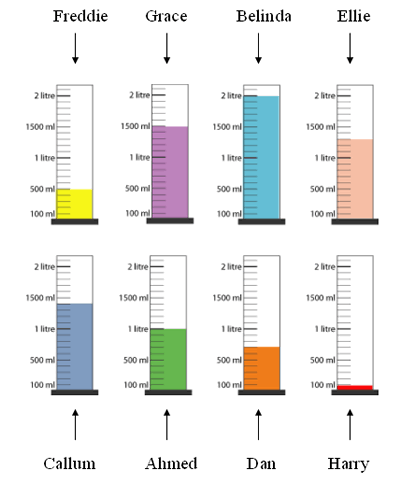Or search by topic
Number and algebra
Geometry and measure
Probability and statistics
Working mathematically
Advanced mathematics
For younger learners
Oh! Harry!



- Problem
- Getting Started
- Student Solutions
- Teachers' Resources
Thank you for sending in your answers to this problem. Only a few of you explained how you worked it through - particularly clear solutions were sent from Serine, Rukiye from Ashmount School, Rhal and Nikhil at Buckingham College Prep, Oliver and Frederica, Mya and Ciara from Hotwells Primary School. Here is what Serine told us:
Referring to the clues given, the first thing I looked at was Ahmed's because it gives the exact amount which is thousand millilitres. According to that number I can use it to find out the rest of the numbers.It is said that Belinda's amount is twice as Ahmed's so it equals 2000 millilitres.
Grace measured three quarters of the amount Belinda has. Then the amount will be 1500 millilitres.
The next clue is that Freddie has half of the amount Ahmed has.
There are other clues as well and one says Callum's is blue. There are two blues but because Belinda has the light blue so Callum must have the darker blue. Answer: 1400ml
Another one was that Ellie's is pink and Dan's is orange. Answer: Ellie-1300ml, Dan-700ml - together 2000ml
For the last question I wonder if the picture showed the measure after the accident or not. If it is, the answer would be 100ml, if not it can be zero or other numbers.
Serine sent in a picture with the measuring cylinders labelled:

It's a good point about Harry's cylinder. We don't know whether the picture shows the amount before or after the accident, so your answer will depend on what you assumed.
You may also like
The Big Cheese
Investigate the area of 'slices' cut off this cube of cheese. What would happen if you had different-sized block of cheese to start with?
Making Boxes
Cut differently-sized square corners from a square piece of paper to make boxes without lids. Do they all have the same volume?

